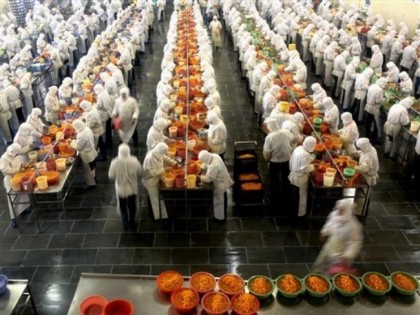 My wife and I recently traveled to Seattle to visit her ninety-six-year-old Godmother, and along the way found ourselves hungry at the airport. The options for eating at airports have improved immensely, but our particular American penchant for fast food still dominates. Airports, naturally, include many people “on the go” and fast food is sometimes all a hurried traveler has time for.
My wife and I recently traveled to Seattle to visit her ninety-six-year-old Godmother, and along the way found ourselves hungry at the airport. The options for eating at airports have improved immensely, but our particular American penchant for fast food still dominates. Airports, naturally, include many people “on the go” and fast food is sometimes all a hurried traveler has time for.
Nonetheless, eating in this way transforms food into a utility, a full step below a commodity, which is in itself a full step below partaking of a meal. This is by no means just the experience at an airport; food-as-utility has spread into America’s everyday lives.
Of all the activities of being human, cultivation, preparation and eating food is one of the most central, an activity shared by people all over the globe. Coming together around the hearth as a family and community is an ancient and powerful act of unity, one which celebrates sharing the bounty of the land, the time-honored tradition of food preparation and the sensual experience of taking time to appreciate what one eats. Yet, like so much else in modern culture, the simple act of taking time to enjoy a meal with others is fading in the speedy pace of our crazy-busy lifestyle.
What’s more, the effects of this change resonate all the way back through those who prepare and serve our food to the way we grow it and treat the land it comes from. When food becomes a utility it loses almost all of its cultural and nutritional value. Those who prepare fast food become little more than human-robots programmed to operate the fast-food machine, toiling like factory workers at minimum wages. As with any machine-oriented operation, efficiency is king; matters of quality and healthiness are secondary. The ingredients being prepared to go into customers’ bodies is just stuff.
The same happens to the food itself; tomatoes engineered for a long-shelf life stay firm and red but end up tasteless and pulpy. Mass-produced, feed-lot beef ground in a factory and shipped as pre-formed patties result in meat that’s overcooked to insure any pathogens are killed. The entire process respects nothing but efficiencies and profit margins.
And the land itself upon which the food is raised receives the same sort of industrial treatment. Agribusiness insures that few people as possible see and handle the produce; mechanization has replaced both farmers and farming. As crops become “stuff” so does the land used to grow them; artificial fertilizers, herbicides and pesticides turn topsoil into lifeless dirt.
Ultimately, this results in consumers who don’t eat; like captive livestock, they feed. The psychology of food-as-utility completes its cycle in the lifestyle of Americans who have not only lost their connection with the land, but also their connection to food itself. Fewer people cook and then eat meals together; an obsession with “celebrity chefs” and food fetishes are symptoms of psychological displacement of our sense of loss, fear and loneliness about food and eating. We do, after all, start life at a mother’s breast where our relationship with food and other beings has its intimate beginning.
And right now, at ninety-six, my wife’s Godmother stands at her stove carefully preparing dinner for us before we gather together at her table and eat. Amen to that.





Right on Larry…
That is why the Coyote makes 40 to 50 loaves of wholegrain seeded sourdough bread every week…..Get on the gravy train and get you some good coyote Bread…….With a little organic coffee….. it is the best nutrition money can buy…..
We should have left the television in the kitchen so we could cook during the commercials.